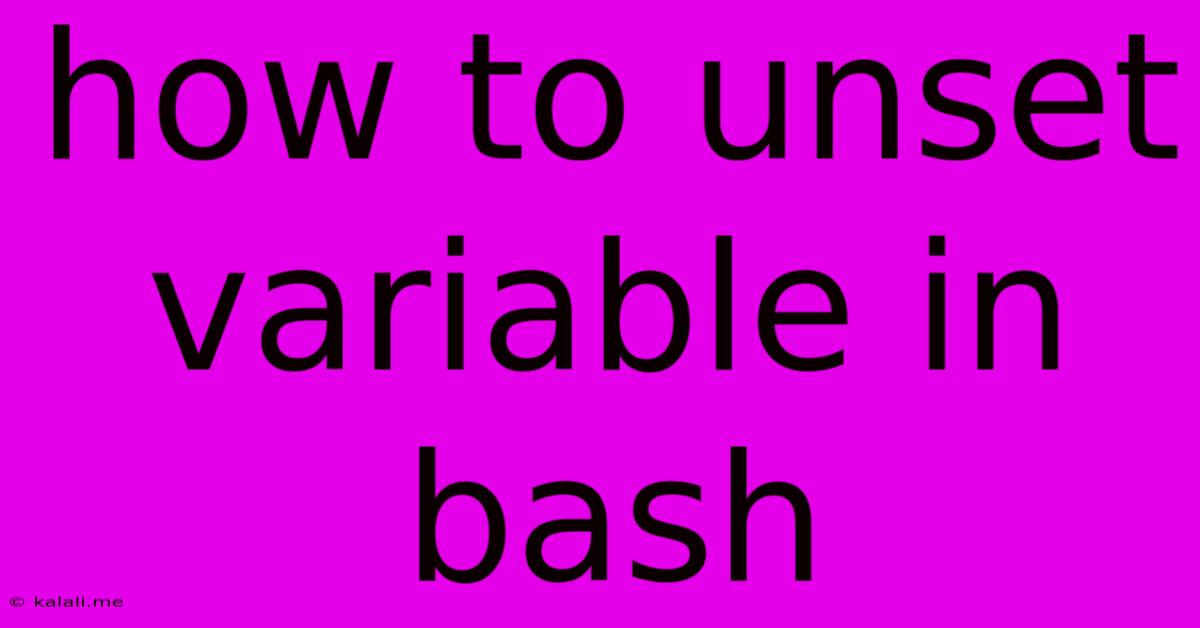How To Unset Variable In Bash
Kalali
May 23, 2025 · 3 min read

Table of Contents
How to Unset Variables in Bash: A Comprehensive Guide
Unsetting variables in Bash is a crucial skill for any shell scripting enthusiast. Knowing how to effectively remove variables from your shell's environment ensures cleaner scripts, prevents unintended variable conflicts, and improves overall code maintainability. This guide will walk you through several methods, offering best practices and addressing common scenarios. Whether you're a beginner or experienced, you'll find this resource valuable for mastering variable management in Bash.
Why Unset Variables?
Before diving into the 'how', let's understand the 'why'. Unsetting variables is important for several reasons:
- Resource Management: Unnecessary variables consume memory, albeit minimally. In large scripts or long-running processes, releasing unused variables can contribute to better resource management.
- Preventing Conflicts: Accidentally using the same variable name with different values can lead to unexpected behavior and bugs. Unsetting variables helps prevent such naming collisions.
- Script Cleanup: Removing variables that are no longer needed makes your scripts cleaner, easier to read, and easier to debug. This improves maintainability and collaboration.
- Security: In certain contexts, particularly when handling sensitive data, unsetting variables after use is a crucial security best practice to prevent data leaks.
Methods for Unsetting Variables
Bash provides a straightforward command for removing variables: unset.
Basic Usage:
The simplest way to unset a variable is using the unset command followed by the variable name:
unset my_variable
This command will remove my_variable from the current shell's environment. Any subsequent attempts to access my_variable will result in an empty value or an error, depending on the context.
Unsetting Multiple Variables:
You can unset multiple variables at once by separating their names with spaces:
unset variable1 variable2 variable3
Unsetting Variables with Special Characters:
If your variable name contains spaces or special characters, enclose it in double quotes:
unset "my variable with spaces"
Important Considerations:
- Read-only Variables: You cannot unset read-only variables using
unset. Attempting to do so will result in an error. Read-only variables are typically created using thereadonlycommand. - Environment Variables: Unsetting an environment variable removes it only from the current shell. It will not affect child processes or subsequent shell invocations unless explicitly exported again.
- Arrays: You can unset array variables using the
unsetcommand. However, it removes the entire array, not individual elements. To remove individual elements, you need to modify the array directly.
Advanced Scenarios and Best Practices
- Conditional Unsetting: It's often beneficial to unset variables conditionally, based on specific conditions in your script. This can be achieved using
ifstatements:
if [ some condition ]; then
unset my_variable
fi
-
Function Scope: Variables declared within a function have local scope. They are automatically unset when the function completes execution. This behavior helps avoid accidental variable collisions between different parts of your script.
-
Cleanup at the End of a Script: It's a good practice to unset variables at the end of your script, especially those that contain sensitive information, to ensure proper cleanup.
-
Debugging: If you're unsure whether a variable exists or has been properly unset, you can use the
declare -pcommand to inspect variable attributes.
By mastering these techniques, you'll write more robust, secure, and efficient Bash scripts. Remember that clean and well-managed variables contribute significantly to code quality and maintainability.
Latest Posts
Latest Posts
-
7am To 11am Is How Many Hours
Jul 12, 2025
-
If Your 35 What Year Was You Born
Jul 12, 2025
-
How Many Cups Is 1 Pound Of Cheese
Jul 12, 2025
-
30 X 30 Is How Many Square Feet
Jul 12, 2025
-
How Much Does A Half Oz Weigh
Jul 12, 2025
Related Post
Thank you for visiting our website which covers about How To Unset Variable In Bash . We hope the information provided has been useful to you. Feel free to contact us if you have any questions or need further assistance. See you next time and don't miss to bookmark.